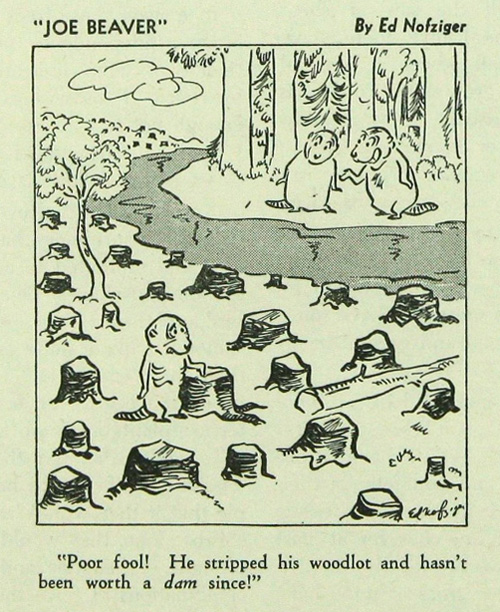Forgotten Characters from Forest History: Joe Beaver
Everyone knows Smokey Bear, Woodsy Owl, and maybe even Ranger Rick Raccoon, but there are many other forest and forestry-related fictional characters that long ago fell by the wayside. Peeling Back the Bark's series on “Forgotten Characters from Forest History” continues with Part 15, in which we examine Joe Beaver.
 Before there was a Smokey Bear or a Woodsy Owl, the U.S. Forest Service had another animal preaching the messages of forest conservation and fire prevention: Joe Beaver. Joe (an actual beaver, not the 8-time world champion cowboy) was the creation of legendary cartoonist Ed Nofziger, who worked for the Forest Service during World War II before moving on to the large animation studios of his day. The story of Joe Beaver’s creation is intertwined with Nofziger’s divergent career path into the world of forestry.
Before there was a Smokey Bear or a Woodsy Owl, the U.S. Forest Service had another animal preaching the messages of forest conservation and fire prevention: Joe Beaver. Joe (an actual beaver, not the 8-time world champion cowboy) was the creation of legendary cartoonist Ed Nofziger, who worked for the Forest Service during World War II before moving on to the large animation studios of his day. The story of Joe Beaver’s creation is intertwined with Nofziger’s divergent career path into the world of forestry.
Ed Nofziger was born in 1913 and raised in California, graduating with an art degree from UCLA in 1936. His work as a cartoonist soon took him to New York, where he became a regular contributor to the Saturday Evening Post and other publications. The outbreak of World War II altered his career path, though, bringing him renown he might otherwise have never attained.
As a member of the pacifist Church of the Brethren, Nofziger was a conscientious objector during the war. When conscripted in 1943 he was assigned to the Forest Service as an alternative to military duty. Nofziger was first sent to a Forest Service station in Cooperstown, New York. Despite having no previous forestry experience (other than being the son of a West Coast lumberman), he took to the work and soon put his own unique skills to good use. Nofziger came up with the idea for Joe Beaver as a way to combine humor with a message of forest conservation.
The Joe Beaver cartoon first appeared in The Otsego Forest Cooperator, a publication of the Otsego Forest Products Cooperative Association in Cooperstown. The character was successfully received, and the Forest Service decided to promote the cartoon on a national level. In 1945 Nofziger was transferred to the USFS office in Philadelphia as Joe Beaver's audience continued to grow. The Forest Service distributed the comic to lumber and trade journals and other publications throughout the country.

Dr. Hardy L. Shirley, the director of the Northeastern Forest Experiment Station for whom Nofziger worked in Philadelphia, described Joe Beaver as “a practical woodsman who is part philosopher, part forester and part hard-headed business man.”
Besides speaking, though, Joe Beaver didn’t take on other human characteristics like similar animal characters. Joe never wore clothes or a hard hat, for example (a la Benny Beaver and others). He was presented as a regular beaver living in the forest, dedicated to spreading the message of conservation.
Nofziger and the Joe Beaver character continued to get more publicity as the cartoon spread nationwide. The overseas service edition of Life magazine in August 1945 featured Joe Beaver cartoons in the "Speaking of Pictures" section. Life had this to say about Joe: "His toothy grin is not that of a clown; it comes, rather, from the bustling good spirits of someone trying to get a job done and done well. Joe is smart, practical and has the native pride of a skilled craftsman. Despite the sarcastic spoofing of his slow-witted beaver pals, Lumberman Joe feels a deep sense of responsibility and concern for their welfare, their sometimes crude work methods and, above all, for America's forests."
Feature articles on Nofziger and Joe also appeared in the New York Herald Tribune (September 9, 1945) and the Long Island Star-Journal (January 10, 1946), the latter of which declared: "A man who never studied a stump of forestry in his life, Nofziger is making the experts in timber conservation all over the country sit up and take notice--and all with the air of one who feels he hasn't done enough."
Despite this success, Nofziger never received any extra income for the Joe Beaver character, who was officially owned by the Forest Service. This didn’t bother him. “Joe is trying to do a service for the people of this country and better forestry,” Nofziger stated in an interview. “He does not contribute to my family income. He is a public service. He is given away free.”
While with the Forest Service, Nofziger also completed the short book Two Trees, created from hand-carved linoleum prints. This story of two trees named Ashton and Elmer provided a message to children of the importance of proper forest management.

Nofziger kept turning out Joe Beaver cartoons through the end of the 1940s. His career aspirations eventually led him back to California. He moved on from the Forest Service and into full time animation, working for UPA studios drawing "Mister Magoo" cartoons and later for Hanna-Barbera where he drew "Ruff and Ready" and other characters. (While at Hanna-Barbera he may have been involved with the Sniff and Snuff characters, but we don't have confirmation of that.)
Nofziger passed away on October 16, 2000. In his obituary published in the Los Angeles Times, fellow artist Roger Armstrong praised him as one of "the finest cartoonist of animals in the last half-century."

Continue after the jump below for a small selection of classic Joe Beaver cartoons.









